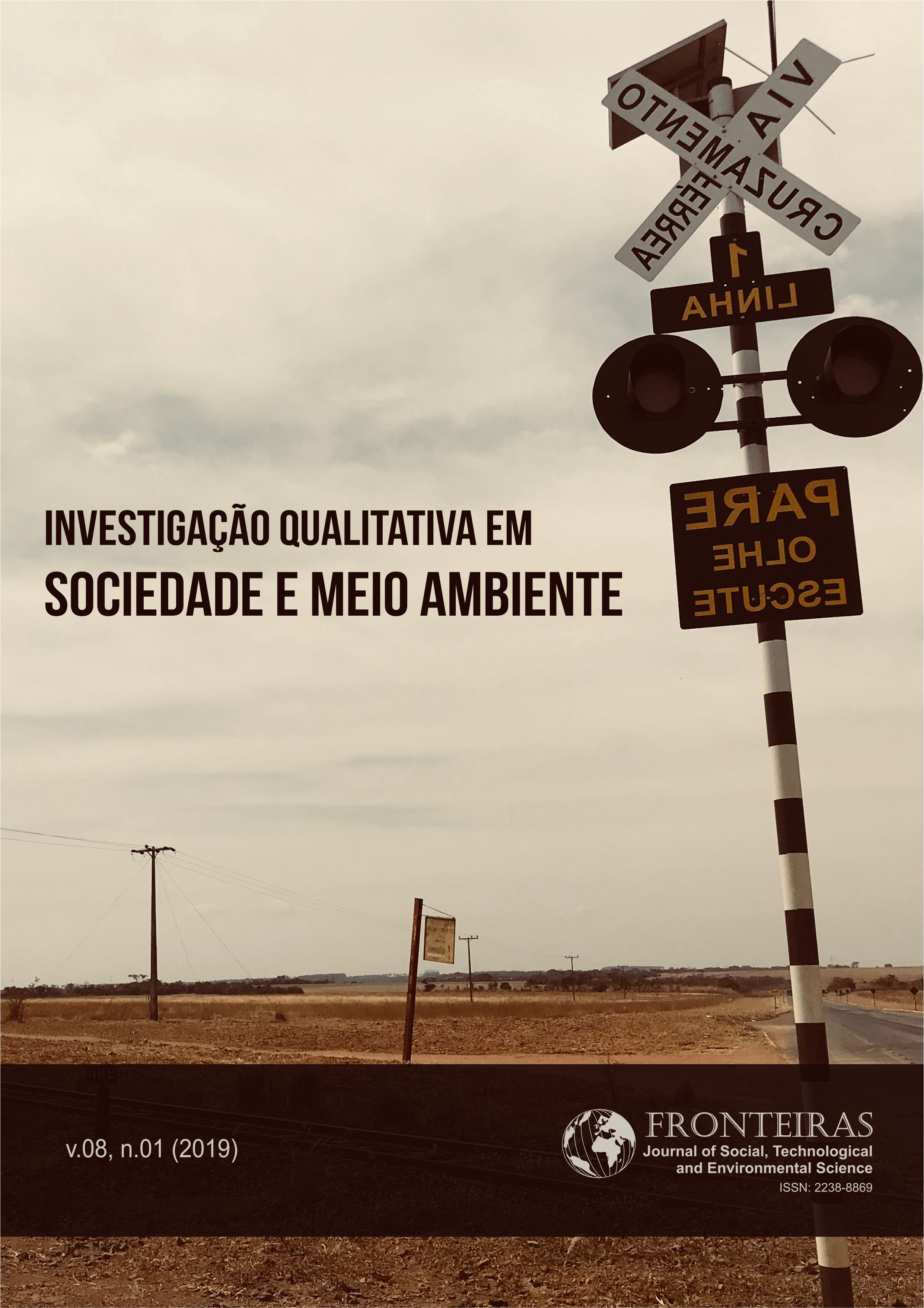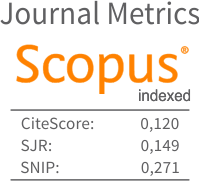A Biodiversidade na Era da Globalização: Mercado Internacional e Degradação Ambiental como Vetores de Simplificação da Biosfera
DOI:
https://doi.org/10.21664/2238-8869.2019v8i1.p185-213Palavras-chave:
Biodiversidade, Globalização, Bioinvasão, Mudanças Ambientais GlobaisResumo
Historicamente, a introdução de espécies exóticas nos territórios caracterizou a história humana, contribuindo para a expansão do sistema econômico. Entretanto, a globalização hegemônica atual, devido ao seu ritmo, intensidade e extensão da degradação ambiental que lhe é peculiar tem conduzido à introdução de espécies exóticas e à perda da biodiversidade em escalas inéditas. O objetivo deste trabalho é investigar os processos relacionados à globalização que contribuem para a intensificação do processo simplificação da biodiversidade do planeta. Para tanto, foi realizada pesquisa em bases de dados secundários e documentos, além de revisão da literatura. Os resultados indicam que com a intensificação dos processos relacionados à globalização, a partir de meados do século XX, está em curso um processo de homogeneização da biosfera sem precedentes na história do Planeta. Além das implicações evolutivas e ecológicas, a própria reprodução das sociedades humanas estaria comprometida em um contexto de menor diversidade biológica.
Referências
Ballouard, JM, Brischoux F, Bonnet, X 2011. Children prioritize virtual exotic biodiversity over local biodiversity. PLoS ONE 6(8).
Biondi D, Predosa-Macedo J H 2008. Plantas invasoras encontradas na área urbana de Curitiba (PR). Floresta, 18, p. 129-144.
Brasil 2016. Quinto relatório nacional para a convenção sobre diversidade biológica. Ministério do Meio Ambiente. Secretaria de Biodiversidade e Florestas; Coordenador Carlos Alberto de Mattos Scaramuzza. Brasília: MMA.
BRIGHT C 1999. Globlization at work: Invasive species: pathogens of globalization. Foreign Policy, v. 116, p. 51-64.
CDB - Convention on Biological Diversity 2001. Status, impacts and trends of alien species that threaten ecosystems, habitats and species. Invasive Alien Species. CBD Technical Series No. 1,. 135 p., Secretariat of the Convention on Biological Diversity, Montreal, Québec, Canada. ISBN: 92-807-2007. Disponível em http://69.90.183.227/doc/ publications/cbd-ts-01.pdf
Còro G 2003. Logística, economia global e desafios para o Made in Italy. In: Monié, F, Silva, G (orgs.). A mobilização produtiva dos territórios: instituição e logística do desenvolvimento local. Rio de Janeiro: DP&A, p. 99-142.
Crosby AW 1993. Imperialismo ecológico: a expansão biológica da Europa, 900-1900. São Paulo: Companhia das Letras.
Crutzen PJ 2002. Geology of mankind: The Anthropocene. Nature, 415: 23.
Darrigran G, Escurra de Drago I 2000. Invasion of the exotic freshwater mussel Limnoperna fortunei(Dunker, 1857) (Bivalvia: Mytilidae) in South America. Nautilus, 114(2):69-73.
Didhan RK, Tylianakis JM, Hutchson MA, Ewers RM, Gemmell NJ 2005. Are invasive species the drivers of ecological change? Trends in Ecology and Evolution, 20, p. 470-474.
Ehrenfeld JG 2010. Ecosystem Consequences of Biological Invasions. Annu. Rev. Ecol. Evol. Syst, 41:59–80
Facon B, Genton BJ, Shykoff J, Jarne P, Estoup A, David P 2006. A general eco-evolutionary framework for understanding bioinvasions. Trends in Ecology and Evolution, 2006, 21, p. 130-135.
Frieden, JA 2008. Capitalismo global: história econômica e política do século XX. Rio de Janeiro: Jorge Zahar Ed.
FAO 2016. The State of World Fisheries and Aquaculture 2016. Contributing to food security and nutrition for all. Rome, 200 pp
Furtado, C 1998. O capitalismo global. São Paulo: Paz e Terra.
Gateway Containers 2017. How shipping containers changed the world. Disponível em: http://www.gatewaycontainersales.com.au/how-shipping-containers-changed-the-world/. Acesso em: 10 de setembro de 2017.
Haberl H, Kherb F, Krausmann V, Gaube A, Bondeau C, Plutzar S, Gingrich W, Lucht M, Fischer-Kowalski 2007. Quantifying and mapping the human appropriation of net primary production in earth’s terrestrial ecosystems. Proceedings of the National Academy of Sciences of the USA, 104, 12942-12947.
Hulme, PE 2009. Trade, transport and trouble: managing invasive species pathways in an era of globalization. Journal of Applied Ecology, Volume 46, Issue 1.
Invasive Species Specialist Group ISSG [database on the internet]. The Global Invasive Species Database. Version 2015.1. [cited 2017 Augusto 29]. Available from: http://www.iucngisd.org/gisd/
IPCC 2013. Summary for Policymakers. In: Climate Change 2013: The Physical Science Basis. Contribution of Working Group I to the Fifth Assessment Report of the Intergovernmental Panel on Climate Change [Stocker, T.F., D. Qin, G.-K. Plattner, M. Tignor, S. K. Allen, J. Boschung, A. Nauels, Y. Xia, V. Bex and P.M. Midgley (eds.)]. Cambridge University Press, Cambridge, United Kingdom and New York, NY, USA.
IPCC 2014. Climate Change 2014: Impacts, Adaptation, and Vulnerability. Part A: Global and Sectoral Aspects. Contribution of Working Group II to the Fifth Assessment Report of the Intergovernmental Panel on Climate Change [Field, C.B., V.R. Barros, D.J. Dokken, K.J. Mach, M.D. Mastrandrea, T.E. Bilir, M. Chatterjee, K.L. Ebi, Y.O. Estrada, R.C. Genova, B. Girma, E.S. Kissel, A.N. Levy, S. MacCracken, P.R. Mastrandrea, and L.L.White (eds.)]. Cambridge University Press, Cambridge, United Kingdom and New York, NY, USA, 1132 pp.
Kolbe J J, Larson A, Losos JB, Queiroz K 2004. Genetic variation increases during biological invasion by a Cuban lizard. Nature, 2004, 431, p. 177-181.
Lacerda SM 2004. Navegação e portos no transporte de contêineres. Revista do BNDES, Rio de Janeiro, v. 11, n. 22, p. 215-243.
Leff H 2006. Racionalidade ambiental: a reapropriação social da natureza. Rio de Janeiro: Civilização Brasileira.
Lenzen M, Kanemoto K, Moran D, Geschke A. Mapping the Structure of the World Economy. Environmental Science & Technology, 46(15), pp.8374-8381.
Lenzen M, Moran D, Kanemoto K, Geschke A 2013. Building Eora: a Global Multi-Region Input-Output Database at High Country and Sector Resolution. Economic Systems Research, 25(1), pp.20-49.
Lowry E, Rollinson EJ, Laybourn AJ, Scott TE, Alello-Lammens ME, Gray SM, Mickley J, Gurevitch J 2013. Biological invasions: a field synopsis, systematic review, and database of the literature. Ecology and Evolution, 3(1): 182-196.
Margulis L, Schwartz K 2001. Cinco reinos: um guia ilustrado dos filos da vida na terra. Rio de Janeiro: Editora Guanabara Koogan, 3ª edição.
Mckinney ML, Lockwood JL 1999. Biotic homogenization: a few winners replacing many losers in the next mass extinction. Trends Ecol Evol, 14(11):450-453.
MCKINNEY ML 2002. Urbanization, biodiversity, and conservation. In: BioScience, 52, p. 883-890.
MEA - Millennium Ecosystem Assessment 2005. Ecosystems and Human Well-being: Synthesis. Island Press, Washington, DC.
MMA – Ministério do Meio Ambiente 2009. Informe sobre as espécies exóticas invasoras marinhas no Brasil / Ministério do Meio Ambiente; Rubens M. Lopes/IO-USP (Ed.). Brasília: MMA/SBF, 440 p.; (Série Biodiversidade, 33).
Mora C, Tittensor DP, Adl S, Simpson AGB, Worm B 2011. How Many Species Are There on Earth and in the Ocean? PLoS Biol. v. 9(8).
Newbold T, Hudson L, Arnell A, Contu S, De Palma A, Ferrier S, Hill S, Hoskins A, Lysenko I, Phillips H, Burton V, Chng C, Emerson S, Gao D, Pask-Hale G, Hutton J, Jung M, Sanchez-Ortiz K, Simmons B, Whitmee S, Zhang H, Scharlemann J, Purvis A 2016. Has land use pushed terrestrial biodiversity beyond the planetary boundary? A global assessment. Science, Vol. 353, Issue 6296, pp. 288-291.
Pagad S, Genovesi P, Carnevali L, Scalera R, Clout M 2015. IUCN SSC Invasive Species Specialist Group: invasive alien species information management supporting practitioners, policy makers and decision takers. Management of Biological Invasions, Vol. 6, Issue 2: 127–135.
Picq P 2016. A diversidade em perigo. Rio de Janeiro: Valentina, 1ª Ed.272p.
Pimentel D, McNair S, Janecka J, WightmanJ, Simmonds C, O’Connell C, Wong, E, Russel L, Zern J, Aquino T, Tsomondo T 2001. Economic and environmental threats of alien plant, animal, and microbe invasions. Agriculture, Ecosystems & Environment 84:1–20.
Porto-Gonçalves CW 2006. A globalização da natureza e a natureza da globalização. Rio de Janeiro: Civilização Brasileira.
PYSEK P, Richardson DM, Pergl J, Jarosík V, Sixtová Z, Weber E 2008. Geographical and taxonomic biases in invasion ecology. Trends in Ecology and Evolution, 23, p. 237-244.
Pysek P, Richardson DM 2010. Invasive Species, Environmental Change and Management, and Health. Annu. Rev. Environ. Resour, 35:25–55
Redford KH, BROSIUS JP 2006. Diversity and homogenization in the endgame. Global Environmental Change, 16, p. 317–319.
Ribeiro WC, Sant’Anna FM 2012. Governança da ordem ambiental internacional. In: Ribeiro, W.C (org.). Governança da ordem ambiental internacional e inclusão social. São Paulo: Annablume; Procam; IEE.
RIDLEY M 2004. Evolution. 3a ed. Oxford: Blackwell Publishing.
Rockström J, Steffen W, Noone K, Persson A, Chapin FS, Lambin, EF, Lenton TM, Scheffer M, Folke C, Chellnhuber HJ, Nykvist B, Wit CA, Hughes T, Leeuw S, Rodhe H, Sörlin S, Snyder PK, Costanza R, Svedin U, Falkenmark M, Karlberg L, Corel RW, Fabry VJ, Hansen J, Walker B, Liverman D, Richardson K, Crutzen P, Foley JA 2009. A safe operating space for humanity.Nature, vol. 461, 472-475.
ROSENZWEIG ML 2001. The four questions: what does the introduction of exotic species do to diversity? Evol. Ecol. Res., 3, p. 361-367.
SAMPAIO AB, SCHMIDT IB 2013. Espécies Exóticas Invasoras em Unidades de Conservação Federais do Brasil. Biodiversidade Brasileira, n.2, p. 32-49.
SANTOS M 2006. Por uma outra globalização: do pensamento único à consciência universal. Rio de Janeiro: Record.
Sax DF, Stachowicz JJ, Brown JH, Bruno JF, Dawson MN, Gaines SD, Grosberg RK, Hastings A, Holt RD, Mayfield MM, O’Connor MI, Rice WR 2007. Ecological and evolutionary insights from species invasions. In: Trends in Ecology and Evolution, 2007, 22, p. 465-471.
Schultz C L 2004. Extinções. In: Carvalho IS (ed.) Paleontologia. vol 1, 2ª ed. Rio de Janeiro: Editora Interciência, p. 115-128.
Simberloff D, Parker IM, Windle PN 2005. Introduced species policy, management, and future research needs. Front Ecol Environ, v. 3, p.12–20.
Simberloff, D 2005. Non-native species do threaten the natural environment. Journal of Agricultural and Environmental Ethics, 18, p. 595–607.
Steffen W, Richardson K, Rockström J, Cornell SE, Fetzer I, Bennett EM, Biggs R, Carpenter S, De Vries W, De Wit CA, Folke C, Gerten D, Heinke J, Mace GM, Persson L, Ramanathan V, Reyers B, Sörlin S 2015a. Planetary boundaries: Guiding human development on a changing planet. Science, Vol. 347, Issue 6223.
Steffen W, Broadgate W, Deutsch L, Gaffney O, Ludwig C 2015b. The trajectory of the Anthropocene: The Great Acceleration. The Anthropocene Review, Vol. 2(1) 81–98.
Strayer DL, Eviner VT, Jeschke, JM, Pace ML 2006. et al. Understanding the long-term effects of species invasions. In: Trends in Ecology and Evolution, 21, p. 645–651.
UNCTAD – United Nations Conference on Trade and Development 2007. Review of Maritime Transport 2007. New York;Geneva: United Nations.
UNCTAD – United Nations Conference on Trade and Development 2008. Globalization for development: the international trade perspective. New York;Geneva: United Nations.
UNEP 2012. Measuring Progress: Environmental Goals & Gaps. United Nations Environment Programme (UNEP), Nairobi.
Vieira EF 2003. Espaços Econômicos: geoestratégia, poder e gestão do território. Porto Alegre: Editora Sagra Luzzatto.
Villéger S, Blanchet S, Beauchard O, Oberdorff T, Brosse S 2011. Homogenization patterns of the world’s freshwater fish faunas. Proceedings of the National Academy of Sciences of the United States of America, vol. 108, n. 44.
Vitousek PM, Mooney HA, Lubchenco J, Melillo JM 1997. Human domination of earth’s ecosystems. Science, New Series, vol. 277, No. 5325: 494-499.
Wilson E 1994. Diversidade da vida. Rio de Janeiro: Companhia das Letras, 447p.
World Bank. Air transport, passengers carried. Disponível em: https://data.worldbank.org/indicator/IS.AIR.PSGR?end=2016&start=1975&view=chart. Acesso em: 12 de novembro de 2017.
Downloads
Publicado
Como Citar
Edição
Seção
Licença
Esta revista oferece acesso livre imediato ao seu conteúdo, seguindo o princípio de que disponibilizar gratuitamente o conhecimento científico ao público proporciona maior democratização mundial do conhecimento.
A partir da publicação realizada na revista os autores possuem copyright e direitos de publicação de seus artigos sem restrições.
A Revista Fronteiras: Journal of Social, Technological and Environmental Science segue os preceitos legais da licença Creative Commons - Atribuição-NãoComercial 4.0 Internacional.


